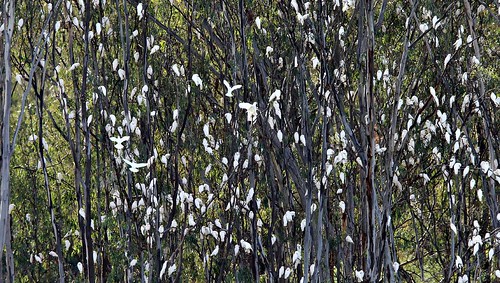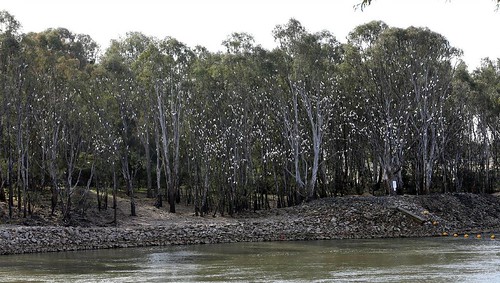 Corellas in trees at Yarrawonga are damaging crops and properties across the region. Pictures: PETER MERKESTEYNHUGE flocks of corellas are eating their way to a rising damage bill across Bundalong, Yarrawonga, Numurkah, and Nathalia.
Corellas in trees at Yarrawonga are damaging crops and properties across the region. Pictures: PETER MERKESTEYNHUGE flocks of corellas are eating their way to a rising damage bill across Bundalong, Yarrawonga, Numurkah, and Nathalia.
“You’d nearly say they’re in plague proportion,” Bundalong South farmer Glenn Nisch said.
“Crops are in and in places, especially close to the river, the cockatoos and corellas are just flogging them.
“They pull the seed out as they’re coming through but even as it’s planted they go along the rows and dig it up and eat the seed.”
Mr Nisch said corellas were a growing problem and particularly bad this year and last.
“It’s very trying when over the years you’ve got rain and everything like that then you’ve got to contend with cockatoos coming and ripping plants up as they’re coming through — chewing into your livelihood,” he said.
“You get several hundred birds in a paddock they can destroy several hectares in no time, especially corellas, they’ll chew anything when they want and they’re a very destructive bird.
“I’ve got a mate who farms along near Bundalong and he’s resigned each year to lose several hectares to birds.”
 Corellas in trees at Yarrawonga are damaging crops and properties across the region. Pictures: PETER MERKESTEYNMoira Shire councillor Wendy Buck said problems were often exacerbated by their social nature.
Corellas in trees at Yarrawonga are damaging crops and properties across the region. Pictures: PETER MERKESTEYNMoira Shire councillor Wendy Buck said problems were often exacerbated by their social nature.
“The chewing habits of the birds have caused significant damage at the Numurkah Showgrounds and Recreation Reserve, with over $15,000 of damage being caused to lighting and sporting surfaces,” she said.
“More than half of the lights at the showgrounds are not working due to chewed wiring.
“They have also caused damage to the optic fibre cabling in the telecommunication tower in Numurkah as well as to the Numurkah Golf Course.”
Damage in other towns includes the deleafing of trees and damage to residential houses.
“While the damage is significant, the options available to council for their management are limited,” Cr Buck said.
Residents needing more information on how they can manage the problem of corellas can contact the Department of Environment and Primary Industries by phoning 136 186 or visiting dse.vic.gov.au.